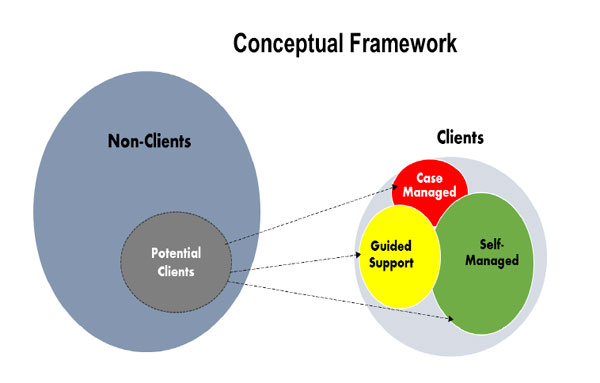Fast facts on...
This publication is available upon request in alternate formats.
PDF Version
Health Care Use Among VAC Clients
Health care costs tend to be concentrated among a small proportion of the population with high levels of need. Veterans Affairs Canada (VAC) examined trends in the use of its health care benefits among clients over the period 2011-2012 to 2015-16. It also explored the extent to which high-cost use could identify a subset of the client population that would benefit from more support in navigating the health care system and reintegrating into civilian life. Clients were divided into four groups based on spending patterns: high-cost users (top 5%), moderate-cost users (6-49%), low-cost users (bottom 50%) and non-health care users.
- 1) Conceptual Framework Model
- Clients may have different levels of care needs over time, and move between these levels as their needs change.
- Greater outreach efforts may be required for potential clients who, once screened, could be triaged into the appropriate level of care.
- 2) Spending Patterns among VAC Clients
- While overall health care costs remained stable over this four-year period, costs for Canadian Armed Forces (CAF) clients more than doubled.
- Costs are concentrated among high-cost users for both CAF clients (the top 5% accounted for 1/3 of spending) and war service clients (the top 5% accounted for 1/4 of spending).
- 3) Screening and Case Management
- There was little relationship between high-cost use and risk level. Many high-cost users scored as minimal or low risk for institutionalization and/or re-establishment in civilian life, below the level for referral to case management.
- Over 1/3 of those being case managed scored as minimal or low risk, and most high-cost users were not being case managed.
- 4) Implications
- Screening and case management appear to be more program than needs based — 87% of those being actively case managed were in the Rehabilitation Program.
- Findings are being used to review Departmental screening tools and the criteria for determining the need for case management.

Conceptual Framework...
Non-Clients
Potential Clients
Clients
Case Managed
Guided Support
Self-Managed
Info Brief References (High-cost Users of Health Care):
MacLean MB, Van Til L, Macintosh S, Poirier A and McKinnon K. High-Cost Users of Health Care Among Veterans Affairs Canada Clients, Research Directorate, Veterans Affairs Canada, Charlottetown. 8 January 2018: p.29
For full report, contact: VAC.research-recherche.ACC@vac-acc.gc.ca